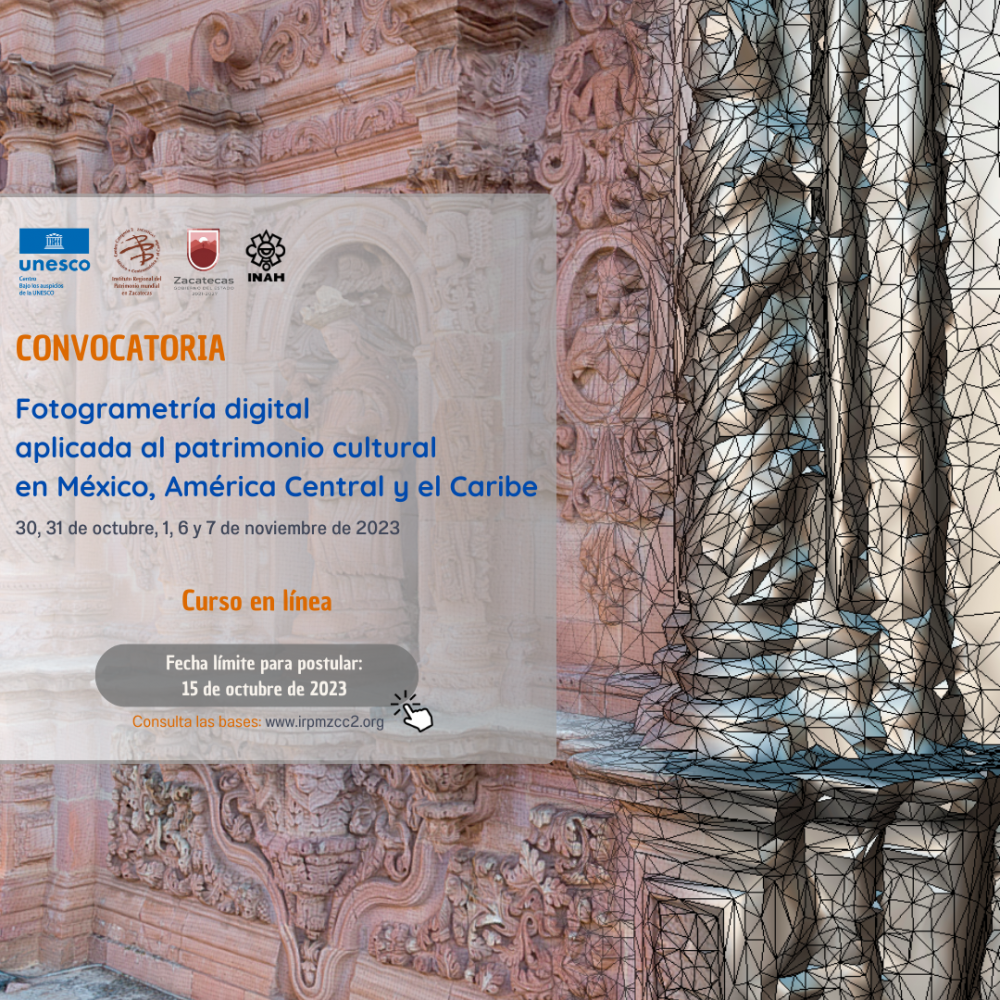Digital Photogrammetry Course
CALL FOR APPLICATIONS
International Course on Digital Photogrammetry
Applied to Cultural Heritage in Mexico, Central America, and the Caribbean
Dates: October 30, 31, and November 1, 6, and 7, 2023
Modality: Online Application
Deadline: October 15, 2023
General Information
Cultural heritage, with its monuments and sites, is constantly threatened with deterioration and destruction. Therefore, it is essential to adopt ongoing actions for its protection and conservation, using scientific and modern methods when conditions permit. The first and most basic step in conserving cultural heritage is its documentation; this allows us to prove or accredit the existence of something and that it exists in this form, with its specific characteristics. Cultural heritage documentation informs various actions not only for its protection and conservation but also for its research, intervention, and dissemination. Documentation is also an indispensable element in risk management for cultural and world heritage, as it prepares for damage mitigation and response to events associated with natural disasters. A reliable record of a heritage asset allows for the definition of intervention and restoration strategies. This is why it is of great importance for Mexico, Central America, and the Caribbean, a region threatened by various natural phenomena such as earthquakes, hurricanes, and volcanic eruptions, which can and have resulted in the destruction of heritage sites.
With the development and rise of digital technologies in recent years, the field of cultural heritage documentation has benefited from the use of improved and new techniques, such as 3D scanning, which enables the creation of a virtual replica of almost any object with all its morphological and visual characteristics. 3D scanning contributes to the conservation of historical and archaeological monuments, not in a physical sense, but by digitally preserving information about heritage assets (morphology, color, and texture), in addition to facilitating decision-making when carrying out an intervention. Currently, one of the most widely used 3D scanning techniques due to its versatility and low cost is digital photogrammetry; the term means measuring based on photographs, and it is a technique that has been evolving in recent years, during which time it has incorporated new concepts and technologies, enabling virtual reconstructions using digital photographs and photogrammetric software.
For this reason, technologies such as digital photogrammetry can be of great help to a region with a high potential for natural disasters. Unlike other documentation techniques, 3D scanning is capable of recording the entirety of an asset, covering virtually all of its areas. Furthermore, it is worth mentioning the affordability of photogrammetry compared to other technologies, making it accessible to virtually any type of institution.
Finally, the objective of the course is to provide participants with knowledge and mastery of photogrammetry, focused on the three-dimensional scanning of real estate or built heritage. This technology allows for precise documentation of the asset, generating a virtual copy suitable for computer manipulation for various purposes. At the end of the course, participants will have the skills and knowledge necessary to apply this technique to their own built cultural heritage, scanning all or part of real estate assets, for example, facades, walls, roofs, domes, etc.
Course Concept
The course will provide participants with the skills and knowledge necessary for digital photogrammetry, starting with proper photography using SLR cameras or smartphones. Participants will then be taught how to use photogrammetric software for data processing, and finally, they will be instructed on how to generate 3D digitalization products such as orthomosaics and digital elevation models.
This activity consists of five online sessions in Spanish via the Zoom platform, scheduled for October 30 and 31, and November 1, 6, and 7, 2023, from 8:00 a.m. to 12:30 p.m. Mexico City time.
|
País |
|
|
8:00 am - 12:30 pm |
Ciudad de México, México Ciudad de Guatemala, Guatemala Tegucigalpa, Honduras San José, Costa Rica San Salvador, El Salvador Managua, Nicaragua |
|
9:00 am – 13:30 pm |
Panamá, Panamá Habana, Cuba (6 y 7 de nov.) |
|
10:00 am – 14:30 pm |
Habana, Cuba (30, 31 de oct. y 1 de nov. horario de verano) Santo Domingo, República Dominicana |
Costs and Commitments
There is no registration fee to attend this course, but the use of a computer and internet connection must be covered by the participant. Participants must also commit their time to attend the course and complete the assignments or practical exercises assigned during the sessions. Completion of these activities will be essential to progress to the next phases of the course.
Who is the course for?
The course is aimed at professionals such as architects, restorers, or archaeologists with basic computer skills, who work in:
- Heritage sites, preferably inscribed on the World Heritage List.
- Organizations or institutions responsible for the management of World Heritage properties.
Participants must have a computer and a camera. A computer with 16 GB of RAM or higher and a professional SLR or mirrorless camera are recommended. The minimum requirements are a computer with at least 8 GB of RAM and a smartphone with a camera.
Application Process
Interested applicants have until October 15, 2023, to apply for the course by submitting the following documents:
- Completed application form.
- Official endorsement from the site management institution or the organization supporting your application.
- Curriculum vitae.


